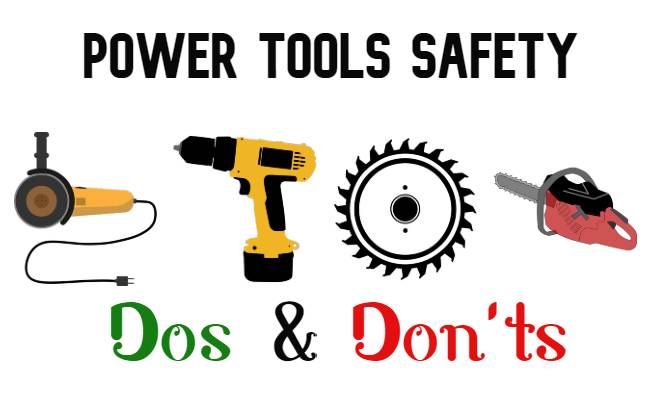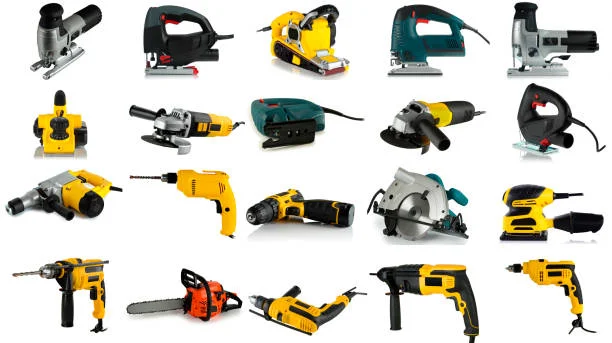When it comes to using portable power tools, safety should always be our top priority. So, what safety precautions should we take to protect ourselves and others around us? In this article, we’ll dive into the world of portable power tools and explore the essential safety measures you need to know.
Using power tools can be a lot of fun, but it’s crucial to understand the potential dangers they can pose. From electric drills to angle grinders, these tools have immense power, and mishandling them can lead to serious accidents. Don’t worry, though! By following a few simple safety precautions, you can enjoy using your portable power tools while keeping yourself and those around you safe.
In this guide, we’ll cover everything from wearing the right protective gear to using power tools on stable surfaces. So, whether you’re a seasoned DIY enthusiast or just starting, this article will equip you with the knowledge you need to handle portable power tools safely. Let’s dive in and discover the world of power tool safety!
1. Wear protective gear such as safety glasses and gloves.
2. Inspect your tools before each use to ensure they are in good working condition.
3. Follow the manufacturer’s instructions and guidelines for proper tool usage.
4. Keep a clean and organized work area to prevent accidents.
5. Avoid distractions and stay focused on your task.
Remember, prioritizing safety when using portable power tools is crucial for preventing accidents and injuries.

**
Safety Precautions for Portable Power Tools: Ensuring a Secure Working Environment
**
Portable power tools have revolutionized the way we approach various tasks, making them faster and more efficient. However, they also pose significant risks if not handled with care. Whether you’re a professional or a DIY enthusiast, following proper safety precautions is essential to prevent accidents and injuries. In this article, we will discuss some key safety measures to keep in mind when using portable power tools.
**
1. Personal Protective Equipment (PPE): Shielding Yourself from Potential Hazards
**
Personal Protective Equipment (PPE) is the first line of defense when it comes to using portable power tools safely. Always wear the necessary protective gear, including safety glasses, gloves, earplugs or earmuffs, and a dust mask when appropriate. Safety goggles or glasses will protect your eyes from flying debris, while gloves can prevent cuts and scrapes. Earplugs or earmuffs are crucial to safeguard your hearing from the loud noise emitted by power tools. Additionally, wearing a dust mask is important to avoid inhaling hazardous particles or fumes.
Using appropriate PPE will significantly reduce the risk of injuries and ensure your safety while operating portable power tools. Make it a habit to check your gear before each use to ensure it’s in good condition and fits properly. Replace any damaged or worn-out equipment immediately to maintain the highest level of protection.
**
2. Familiarize Yourself with the Tool: Read the Manual and Understand its Functionality
**
Before using any portable power tool, it is essential to familiarize yourself with its features, functions, and potential hazards. Start by thoroughly reading the user manual provided by the manufacturer. This will give you valuable insights into the tool’s specifications, safety guidelines, and maintenance instructions. Understanding how the tool works and its limitations will help you use it safely and efficiently.
Inspect the tool before each use to ensure it is in proper working condition. Check for loose wires, damaged cords, or any signs of wear and tear. If you notice any defects, refrain from using the tool until it has been repaired by a professional. Remember, the key to safe tool operation is knowing how to use it correctly and recognizing when it requires maintenance or repair.
**
3. Maintain a Safe Working Environment: Organize and Clear the Area
**
Creating a clean and organized workspace is crucial when working with portable power tools. Cluttered areas increase the risk of accidents and can lead to potential hazards such as tripping or falling. Before starting any work, clear the area of any unnecessary objects, debris, or obstacles. Keep the surrounding space well-lit, ensuring visibility is not compromised.
Setting up a designated workbench or table for your tools will help keep them organized and easily accessible. This will minimize the chances of accidental damage and prevent any unwanted interactions with other materials or equipment. Store your tools in their designated cases or cabinets when not in use to maintain a safe and clutter-free environment.
**
Additional Safety Precautions for Portable Power Tools
**
**
1. Use the Right Tool for the Job: Match the Tool’s Capabilities to the Task
**
Each portable power tool is designed to handle specific tasks and materials. It is crucial to choose the right tool according to the job at hand. Using the wrong tool not only affects the quality of work but also increases the risk of accidents. Refer to the user manual or seek professional advice to ensure you are using the appropriate tool for the task.
**
2. Power Source Safety: Handle Cords and Batteries with Care
**
When working with corded power tools, pay attention to the electrical cords. Ensure they are properly grounded, free of damage, and not lying in a way that can cause tripping. Use extension cords suitable for the power requirements of your tool and avoid overloading outlets. When using battery-powered tools, keep spare charged batteries on hand and never mix different types or capacities.
**
3. Secure Workpieces: Stabilize Your Materials for Precise and Safe Operation
**
Securing your workpieces properly is essential to prevent them from slipping or shifting during operation. This ensures precise and safe cuts, reducing the risk of injuries. Use clamps or other appropriate methods to hold your materials in place. Avoid holding the workpiece with your hands while operating portable power tools whenever possible.
**
4. Regular Maintenance: Keep Your Tools in Optimal Condition
**
Regular maintenance and inspection of your portable power tools are necessary to keep them in optimal condition. Clean the tools after each use, remove dust and debris, and lubricate moving parts if required. Check for loose screws or connections and tighten them appropriately. Additionally, have your tools inspected by a professional at regular intervals to identify any hidden defects or potential safety concerns.
**
5. Continuous Learning: Enhancing Your Safety Knowledge and Skills
**
As technology evolves, new tools, safety measures, and techniques are introduced. It is important to stay updated with the latest developments in the field. Attend workshops, training sessions, or consult online resources to enhance your knowledge and improve your skills. Continuous learning not only ensures your safety but also allows you to maximize the benefits of using portable power tools.
By following these safety precautions, you can significantly reduce the risk of accidents and create a secure working environment. Remember, safety should always be the top priority when using portable power tools.
Safety Precautions for Portable Power Tools
- Always wear appropriate protective gear, such as safety glasses and gloves, when using power tools.
- Inspect the tool before use for any damage or defects that could cause accidents.
- Ensure the tool is properly grounded and never use it near water or in wet conditions.
- Keep a firm grip on the tool and maintain good balance while operating it.
- Never disable safety features or use the tool in ways it is not intended for.
Frequently Asked Questions
Portable power tools can be incredibly useful, but it’s important to take safety precautions when using them. Here are some common questions and answers related to safety precautions for portable power tools:
1. How can I ensure the safety of my hands when using portable power tools?
When using portable power tools, it’s vital to wear the appropriate safety gloves. Choose gloves that offer protection against cuts, punctures, and abrasions. Additionally, make sure your gloves have a good grip to prevent slipping.
It’s also crucial to keep your hands away from the cutting or drilling area and use clamps or other devices to secure the workpiece. Be mindful of your hand’s position in relation to the tool and make sure to maintain a firm grip on the tool at all times.
2. Are eye protection measures necessary when using portable power tools?
Absolutely! Eye protection is crucial when working with portable power tools. Flying debris or particles can cause severe eye injuries. Always wear safety glasses or goggles that provide impact protection. Make sure they fit well and cover your eyes completely.
Also, keep in mind that regular prescription glasses or sunglasses do not provide sufficient protection. Safety glasses should have side shields to protect against any potential hazards from the side angle. Don’t disregard this safety measure as it can prevent permanent eye damage.
3. How should I handle the power cords of portable power tools?
Power cords should be treated with care to prevent accidents. First, always inspect the cords for any damage before using the tool. If you notice any cuts, frays, or exposed wires, replace the cord before use.
When working with power cords, make sure they are unplugged when not in use or when you need to make adjustments. Avoid yanking the cord forcefully or running it across sharp edges. This will help prevent damage to the cord and reduce the risk of electric shock.
4. What precautions should I take to prevent accidental start-ups of portable power tools?
To prevent accidental start-ups, always disconnect the tool from the power source before making any adjustments or changing accessories. This will eliminate the risk of the tool unexpectedly turning on while you’re working on it.
Additionally, when carrying a portable power tool, make sure the power switch is in the off position. This prevents accidental engagement of the tool and helps maintain control over the tool’s operation.
5. Should I wear hearing protection when using portable power tools?
Absolutely! Many power tools produce high levels of noise that can damage your hearing. Always wear hearing protection, such as earmuffs or earplugs, when operating loud power tools.
Prolonged exposure to loud noises without proper protection can lead to permanent hearing loss. It’s better to be safe than sorry, so protect your ears every time you use a power tool with high noise levels.

Summary
When using portable power tools, it’s important to follow safety precautions. First, avoid wearing loose clothing or jewelry that can get caught in the tool. Second, always use the right tool for the job and check that it’s in good working condition. Third, use protective gear like gloves and safety glasses to keep yourself safe. Fourth, make sure the tool is turned off and unplugged when not in use. Finally, be mindful of your surroundings and keep others away from the work area.
In conclusion, by following these safety precautions, you can prevent accidents and injuries when using portable power tools. Stay safe and happy DIYing!
